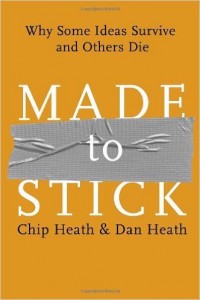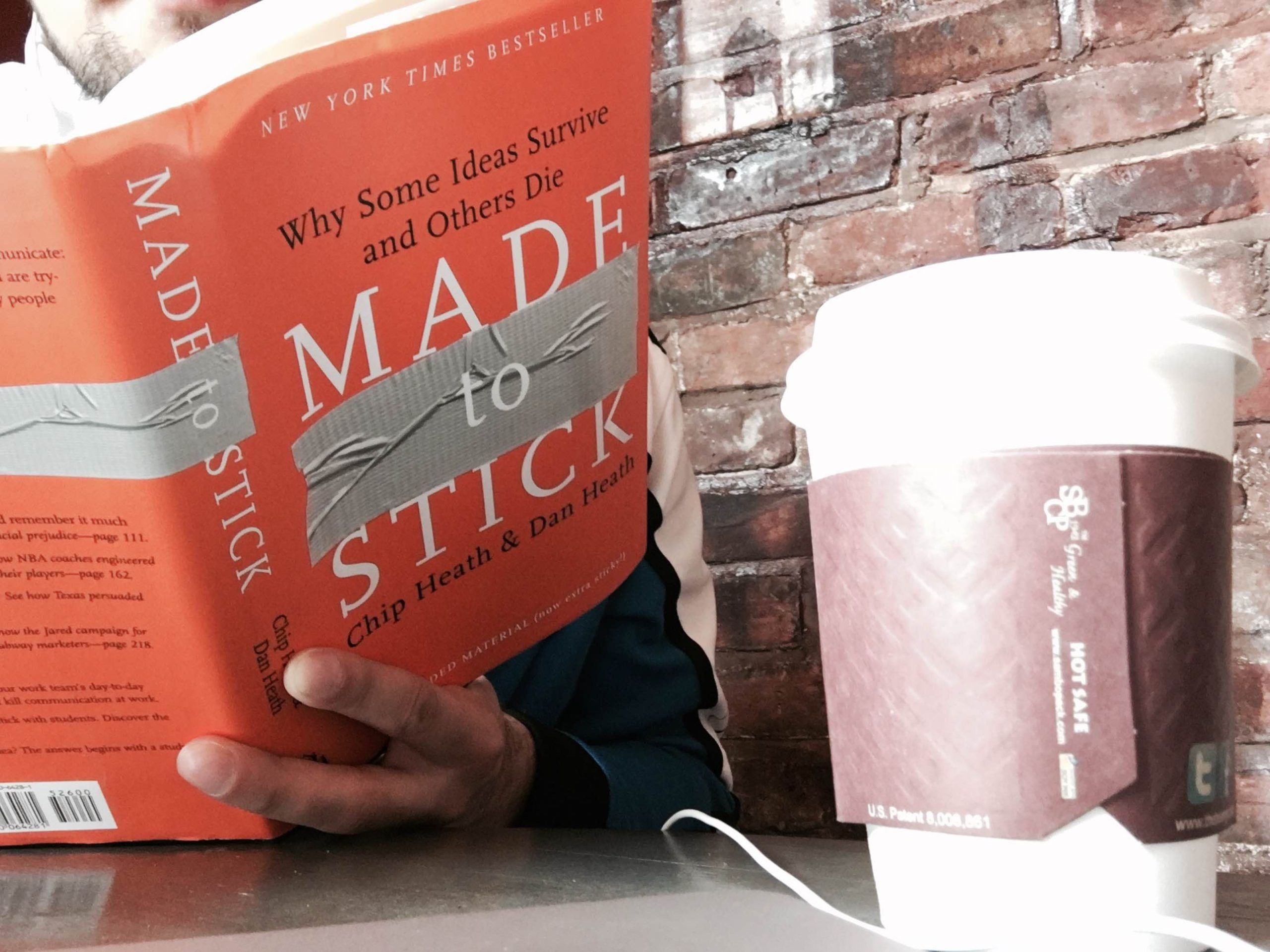I’ve always been that soft-spoken guy who would tell a friend, “You know you really should…” only to have them ignore my advice and then come back in a few months saying that they should have listened to me.
It’s kind of a running joke in my family.
Recently, I’ve been curious as to how I can get more people to actually take my advice and act on it. I stumbled upon this book, Made to Stick: Why Some Ideas Survive and Others Die by Chip Heath and Dan Heath.
 It really delves deep into how the brain is wired to receive and retain certain messages and discard others.
It really delves deep into how the brain is wired to receive and retain certain messages and discard others.
If you’ve ever been wondering why infomercials, political candidates, and bestselling books use a particular type of language or marketing, this is the book for you.
In this blog post, I’m going to be going over some of the major points in this book, along with some of the quotes and passages that stood out to me.
Before I do that, I just wanted to address some of the low-star reviews on amazon. One review reads:
“Well, I appreciated the evidence this book provided about the power of stories and details, but sorry Chip and Dale, I think you are speaking about fast media ideas and not the kind that matter to me.”
The reviewer goes on to say that the book is more focused on the art of persuasion rather than making ideas stick that are hard to remember or that are revolutionary.
Personally, I think that’s complete B.S. Certain ideas are hard to remember for a REASON. The book highlights these reasons quite clearly. Even more, it shows how to reframe ideas that might be hard to remember, so that the audience can actually grasp them.
It’s not the world’s job to understand your ideas. It’s your job to figure out how to make them understand and care about them.
Another reads, “I enjoyed reading this book. I enjoyed it so much I almost bought their ‘argument’ until I realized it was nothing but empty fluff and repackaged common sense, but avoids any in depth insights.”
I don’t see any real fluff in their book. The book does have a lot of examples to back up their claims and beat it into your brain that these techniques work, but you can always skip over them if you’d like.
Also, I don’t think most of the book is based around common sense. If it was, everyone would be using these techniques to market their ideas and products, and most aren’t.
Finally, I’ll highlight this review, “This could have been a very nice book if they wrote 80 pages (like the 1 minute series). Now it is just repetitive and bloated. The ideas are good, but it is very tedious to wade through the pages.”
Haha, the one thing I’d say about this review is that skim reading is a thing. You don’t have to read every word.
The only reason I would recommend staying away from this book is if you already are familiar with the topic. Plain and simple.
Overview of the book & quotes
There are a few different principles that determine how well your ideas stick in the minds of your audience.
Simplicity
Simplicity is all about creating the simplest form of your ideas as possible, like Inception. It comes down to prioritization. “If you say three things, you don’t say anything.”
When you make a choice simple or a message simple for your employees, you remove decision angst. It’s also important when teaching concepts or sharing information about yourself.
- It’s easier to learn new concepts when you tie them to a concept that you already know.
“People are tempted to tell you everything, with perfect accuracy, right up front, when they should be giving you just enough info to be useful, then a little more.”
Unexpectedness
“The first problem of communication is getting people’s attention.”
- Best way to get attention is to break a pattern.
- Surprise gets attention. Interest keeps attention.
- Surprise is when our schema fails. It makes us want to find an answer and resolve the question of why we were surprised.
- For an idea to be sticky, break someone’s guessing machine, and then fix it.
- “Common sense is the enemy of sticky messages.”
- “Mysteries are powerful because they create a need for closure.”
- People want to know how a story will turn out
- To create curiosity, local news programs run teaser ads for upcoming broadcasts.
- To get people interested in a topic, you point out a gab in their knowledge. If someone has an abyss more than a gap, you need to fill in enough knowledge to make the abyss into a gap.
“The value of the stories does not come from unexpectedness in and of itself. The value comes from the perfect alignment between Nordstrom’s goals and the context of the stories.”
“Huge numbers are difficult to grasp and hard to remember.”
“The authors described a state of affairs that seemed to make no sense and then invited the reader into the material as a way of solving the mystery.”
“A secondary effect of being angry is that we become more certain of our judgements.”
Concrete
- Concrete language helps novices understand. Abstract is for the expert.
- Velcro theory of memory. The more hooks an idea has, the better it will cling to memory. Concreteness is a way of mobilizing and focusing the brain.
Credibility
We trust the recommendations of those who we like.
“A person’s knowledge of details is often a good proxy for her expertise.” Detail lends credibility to the teller of the idea and the idea.
The Sinatra test – one example alone is enough to establish credibility in a given domain.
Emotions
“If I look at the mass, I will never act. If I look at the one, I will.”
- Arouse sympathy and compassion.
“The most basic way to make people care is to form an association between something they don’t yet care about and something they do care about.”
“We make people care by appealing to the things that matter to them.”
- You have to spell out the benefit of the benefit. People buy a hanged picture. Don’t assume your audience is intelligent.
“This marketer had been taught that there are three basic consumer appeals: sex, greed, and fear.”
- Appeal to people’s identity.
“How can we make people care about our ideas? We get them to take off their analytical hats. We create empathy for specific individuals. We show how our ideas are associated with thing that people already care about. We appeal to their self-interest, but we also appeal to their identities – not only to the people they are right now, but also to the people they would like to be.”
Stories
“Overall, mental practice alone produced about two thirds of the benefits of actual physical practice.”
“Jared reminds us that we don’t always have to create sticky ideas. Spotting them is often easier and more useful.” A great spotter will trump a great creator.
Three types of plots: challenge, connection, and creativity.
With a story, you are involving the audience with an idea and asking them to participate.
They’re remembering the experience that taught them those lesson – the struggles, the political battles, the missteps, the pain. They are tapping into these experience, but they forget that the audience can’t hear the same tune they hear.
When students are asked to recall the speeches, 63% remember the stories. Only 5% remember any individual statistic.
For an idea to stick, it must make the audience:
- Pay attention
- Understand and remember it
- Agree/Believe
- Care
- Be able to act on it.
On taking action:
“If we do nothing else during tomorrow’s mission, we must _______.”
“The single, most important thing that we must do tomorrow is _________.”
